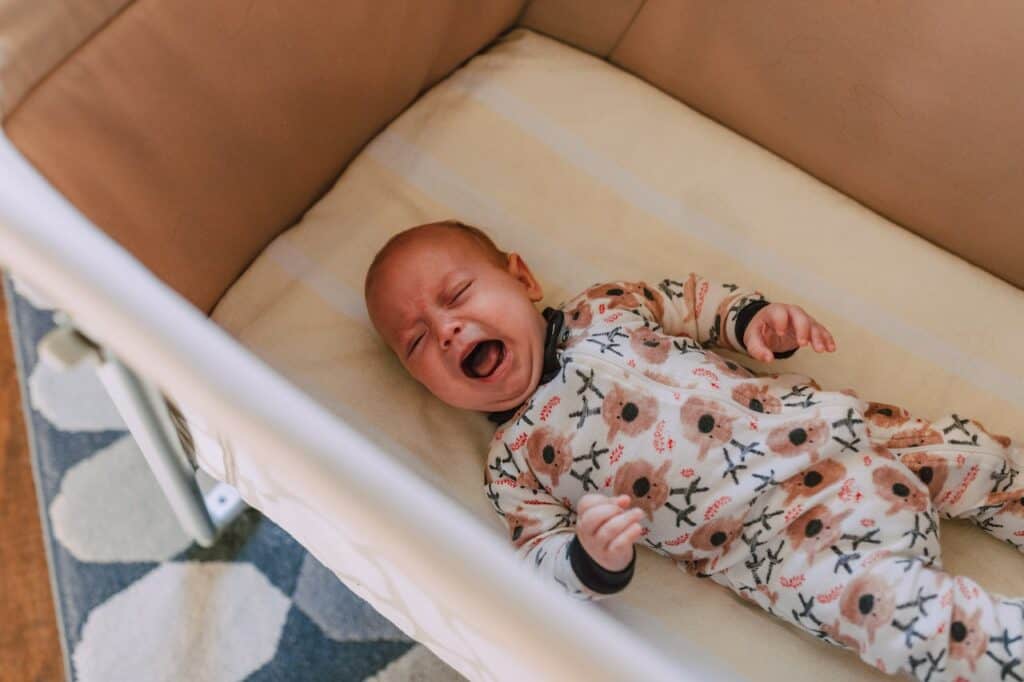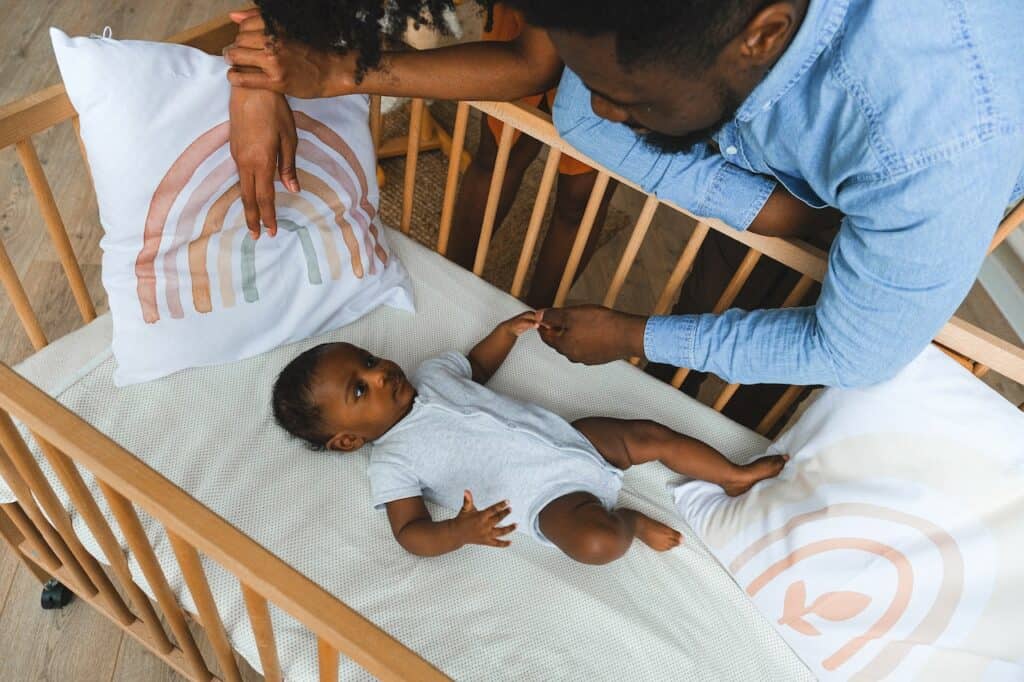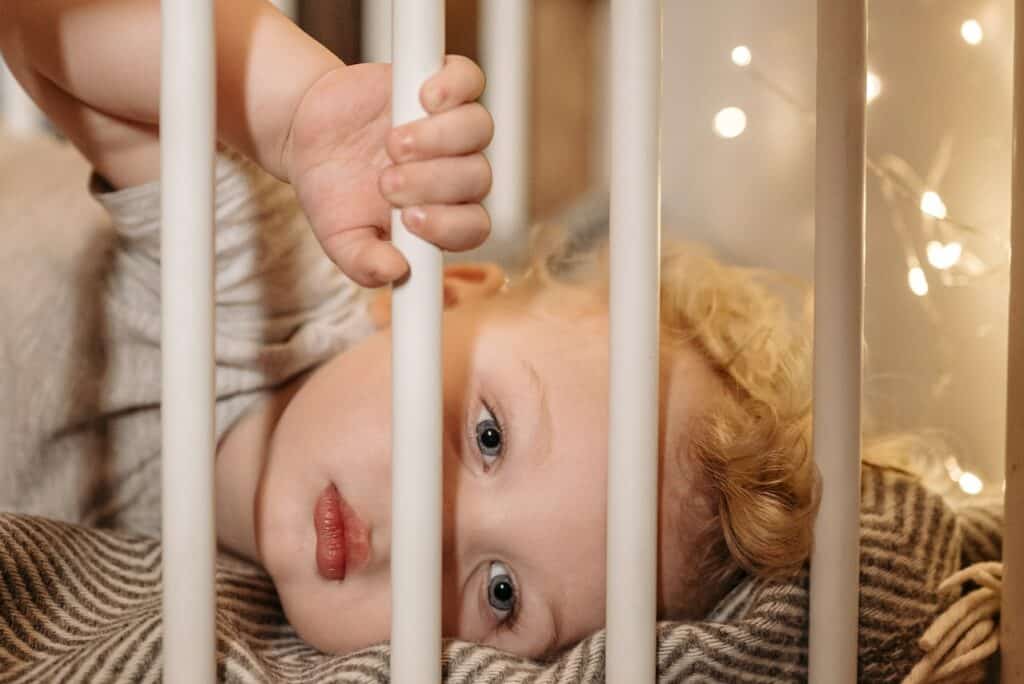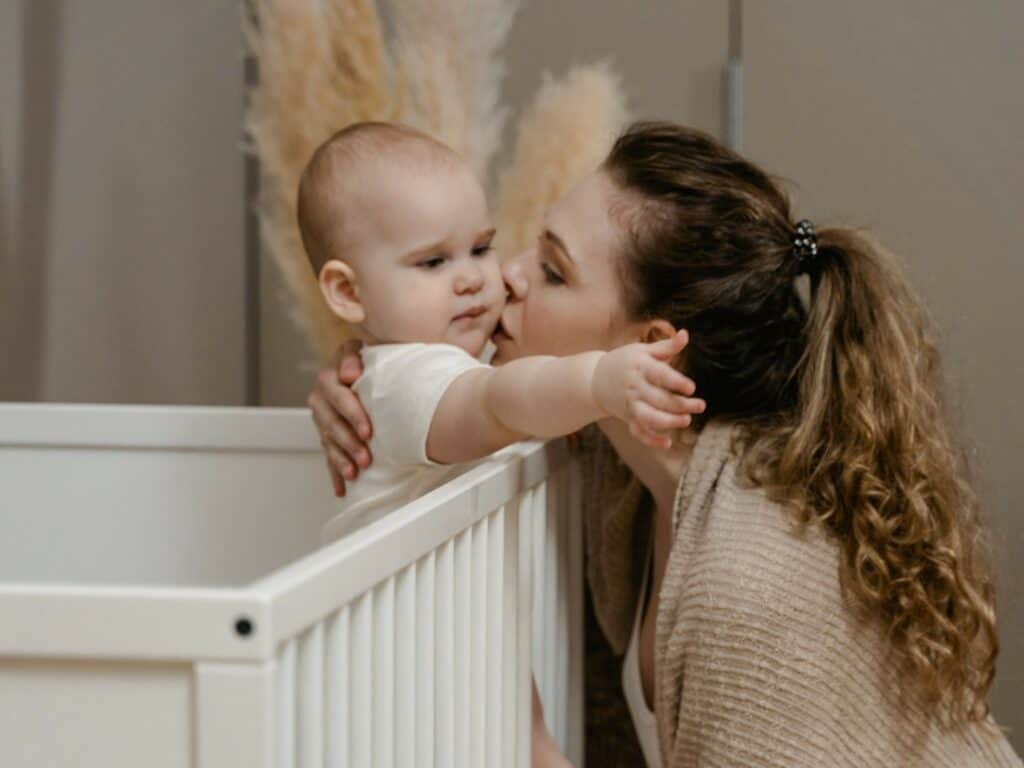Babies are known for their erratic sleeping patterns. They may sleep for hours during the day and wake up at night, or they may sleep for short periods throughout the day and night. One of the most common concerns among new parents is when their baby moves around in the crib while sleeping. This can be alarming, especially if the baby seems to be moving excessively or in an unusual way.
Understanding Baby’s Sleep Cycles is crucial for parents to know what to expect from their baby’s sleep patterns. A baby’s sleep cycle is different from an adult’s, and they may move around more during sleep. Babies usually go through two types of sleep: Rapid Eye Movement (REM) and Non-Rapid Eye Movement (NREM) sleep. During REM sleep, babies may move around more, and their breathing and heart rate may increase. This is normal and is a sign that the baby is in a deep sleep.
Parents should prioritize Sleep Safety in the Crib. While it is normal for babies to move around during sleep, parents should ensure that the crib is a safe sleeping environment. The crib should be free of any loose bedding, toys, or pillows that could pose a suffocation risk. Additionally, parents should ensure that the crib is set up correctly and that the mattress is firm and fits the crib properly.
Key Takeaways
- Babies move around more during sleep due to their sleep cycle.
- Parents should prioritize sleep safety in the crib.
- Excessive movement during sleep can be a sign of discomfort or a medical issue.
Understanding Baby’s Sleep Cycles
Babies have different sleep cycles than adults. They spend more time in REM sleep, which is a lighter sleep stage where they may move around more. Understanding the different sleep cycles can help parents know what to expect and how to help their baby sleep better.

Sleep Cycles
Babies have four different sleep cycles: active sleep, light sleep, deep sleep, and REM sleep. During active sleep, babies may move around and make noises. Light sleep is a transition stage between active sleep and deep sleep. During deep sleep, babies are less likely to move around and may be more difficult to wake up. REM sleep is when babies may move their eyes rapidly and have more dreams.
Naps
Babies need frequent naps throughout the day to get enough sleep. Naps can be short or long, depending on the baby’s age and sleep needs. It’s important to establish a nap routine and stick to it as much as possible.
Sleep Movement
Babies may move around a lot while sleeping, especially during active sleep and REM sleep. This is normal and can even be a sign that the baby is getting quality sleep. However, if the baby is restless or having trouble sleeping, it may be a sign of a sleep disorder or other sleep problem.
Disrupted Sleep
Disrupted sleep can be caused by a variety of factors, including illness, teething, and developmental changes. It’s important to address any underlying issues that may be causing disrupted sleep and to establish a consistent sleep routine.
Nighttime Restlessness
Babies may be more restless at night than during the day. This can be due to hunger, discomfort, or other factors. Parents can try feeding the baby before bedtime, using a comfortable sleep environment, and establishing a bedtime routine to help reduce nighttime restlessness.
Baby’s Movement in Sleep
Babies are known to move around a lot while sleeping in their cribs. It is completely normal and can be attributed to their active nervous system and muscle tone. Some babies are more active sleepers than others, and this can result in them rotating or squirming in their sleep.
Parents may notice that their baby always ends up sideways in the crib or in the corner of the crib. This can be a result of the baby’s rolling movements while sleeping. It is important to ensure that the crib is free of any loose bedding or objects that could pose a suffocation risk if the baby moves around too much.
Swaddling can also affect a baby’s movement in sleep. Some babies may rotate in their crib while swaddled, while others may be more restless and twitchy due to feeling restricted. If parents notice that their baby is consistently uncomfortable while swaddled, they may want to try a different swaddling technique or stop swaddling altogether.
Restless leg syndrome and periodic limb movement disorder are two conditions that can cause a baby to move around excessively in their sleep. These conditions are rare in infants, but if parents suspect that their baby may be suffering from either of these conditions, they should consult a pediatrician.
In conclusion, babies are active sleepers and will often move around in their cribs while sleeping. This is completely normal and should not be a cause for concern. However, parents should ensure that the crib is a safe sleep environment and that their baby is not at risk of suffocation due to loose bedding or objects in the crib.
Sleep Safety in the Crib
When it comes to safe sleep for babies, the crib is the safest place for them to sleep. However, there are some important guidelines to follow to ensure that the crib is as safe as possible.

First and foremost, the crib should have a firm mattress that fits snugly in the crib frame. This helps prevent the baby from getting trapped between the mattress and the sides of the crib. It’s also important to make sure that there are no loose or missing screws, bolts, or other hardware that could pose a danger to the baby.
It’s recommended that parents avoid using blankets, pillows, or bumpers in the crib. These items can increase the risk of suffocation or Sudden Infant Death Syndrome (SIDS). Instead, parents can use a sleep sack or swaddle blanket to keep the baby warm and cozy.
Parents should also avoid placing the baby’s face against the side of the crib, as this can increase the risk of suffocation. The baby should always be placed on their back to sleep, and a pacifier can be used to help reduce the risk of SIDS.
Additionally, parents should avoid placing a mobile above the crib that the baby could reach and potentially pull down. Any toys or other items in the crib should be soft and free of small parts that could be a choking hazard.
Finally, parents should make sure that the crib is placed in a safe location, away from any corners or edges that the baby could bump into. By following these guidelines, parents can create a safe and comfortable sleep environment for their baby.
Concerns and Solutions for Baby’s Sleep Movement
Parents may feel concerned when their baby moves around in the crib while sleeping. While this is a normal behavior for babies, it can cause stress and fatigue for parents who worry about their baby’s safety. In this section, we will discuss concerns related to baby’s sleep movement and offer solutions to help parents address these concerns.
One of the main concerns for parents is the risk of sudden infant death syndrome (SIDS). While there is no known cause of SIDS, it is important for parents to follow safe sleep practices to reduce the risk. This includes placing baby on their back to sleep and avoiding soft bedding and toys in the crib. If a baby is moving around in the crib, parents should reposition them on their back to ensure they are sleeping safely.
Another concern for parents is sleep apnea, a condition where breathing is interrupted during sleep. While it is rare in infants, parents should be aware of the signs, including loud snoring, pauses in breathing, and gasping for air. If parents suspect their baby may have sleep apnea, they should consult with their healthcare provider.
Obstructive sleep apnea can also be a concern for babies who have enlarged tonsils or adenoids. This can cause breathing difficulties during sleep and may require medical intervention. If parents notice their baby is snoring loudly or having difficulty breathing while sleeping, they should consult with their healthcare provider.
Night terrors are another concern for parents, although they are not related to sleep movement. Night terrors are episodes of intense fear or panic during sleep and can be distressing for both the baby and parents. If parents notice their baby is experiencing night terrors, they should consult with their healthcare provider for advice on how to manage them.
In conclusion, while it is normal for babies to move around in the crib while sleeping, it can cause concerns for parents. By following safe sleep practices and being aware of potential sleep-related conditions, parents can help ensure their baby sleeps safely and soundly.
Impact of Sleep Movement on Baby’s Growth and Development
Babies are known to move around a lot in their cribs while sleeping. This movement can range from rolling over to changing positions, and even kicking their legs. While it may seem concerning to some parents, it is actually a normal part of a baby’s sleep cycle.

Studies have shown that sleep movement can have a positive impact on a baby’s growth and development. During sleep, a baby’s brain is actively processing information and forming new connections. Movement during sleep can help stimulate this process and enhance brain development.
In addition to brain development, sleep movement can also aid in physical growth and development. Regular movement during sleep can help strengthen a baby’s muscles and improve coordination. This can lead to reaching developmental milestones such as crawling and walking.
It is important to note that excessive movement during sleep can also be a sign of discomfort or other underlying issues. Parents should always monitor their baby’s movements and consult with a healthcare professional if they have any concerns.
Overall, sleep movement is a natural and beneficial part of a baby’s sleep cycle. It can aid in both physical and cognitive development, and parents should embrace it as a normal part of their baby’s growth.
Feeding, Comfort and Self-Soothing
When a baby moves around in their crib while sleeping, it could be due to a variety of reasons. One common reason is discomfort caused by hunger. If the baby is not getting enough milk during feedings, they may wake up frequently and move around in an attempt to find a more comfortable position. To avoid this, it is important to ensure that the baby is getting enough milk during each feeding session.

Another reason for a baby’s movement in the crib could be due to discomfort in their sleeping position. If the baby is sleeping on their side or stomach, they may not be able to breathe properly, leading to discomfort and restlessness. It is recommended to always place babies on their back to sleep, as it is the safest position for them.
Comfort is also an important factor in a baby’s sleep. Babies may move around in their crib if they are too hot or too cold, or if their clothing is too tight or uncomfortable. It is important to ensure that the baby’s sleeping environment is comfortable and safe, with appropriate clothing and bedding.
Self-soothing is another important aspect of a baby’s sleep. Babies who are able to self-soothe are less likely to wake up frequently and move around in their crib. This can be encouraged by providing a consistent bedtime routine, such as a warm bath, a story, or a lullaby, and by allowing the baby to fall asleep on their own.
In summary, feeding, comfort, and self-soothing are all important factors in a baby’s sleep. Ensuring that the baby is getting enough milk during feedings, sleeping on their back, providing a comfortable sleeping environment, and encouraging self-soothing can all help reduce a baby’s movement in the crib while sleeping.
Related Posts:
Frequently Asked Questions
How can I keep my baby from moving around so much in their crib while sleeping?
It can be challenging to keep your baby from moving around in their crib while sleeping. However, you can try using a swaddle or sleep sack to keep your baby snug and secure. Additionally, you can try placing your baby on their back to sleep, as this is the safest sleeping position for infants.
Why do babies move around so much in their sleep?
Babies move around in their sleep for various reasons. It could be due to discomfort, hunger, or the need for a diaper change. Additionally, babies have a natural instinct to move around and explore their environment, even while sleeping.
What are some tips for getting my baby to stay in one position while sleeping?
To get your baby to stay in one position while sleeping, you can try using a sleep sack or swaddle to keep them snug and secure. Additionally, you can try placing a rolled-up towel or blanket under your baby’s arms to prevent them from rolling over.
Is it normal for babies to rotate in their crib while sleeping?
Yes, it is entirely normal for babies to rotate in their crib while sleeping. Babies have a natural instinct to move around and explore their environment, even while sleeping.
Can moving around in the crib while sleeping be harmful for my baby?
No, moving around in the crib while sleeping is not harmful to your baby. However, it is essential to ensure that your baby is sleeping in a safe environment, free of any hazards that could cause harm.
Should I be concerned if my baby is constantly moving in their sleep?
No, you should not be concerned if your baby is constantly moving in their sleep. It is entirely normal for babies to move around while sleeping, and it is a sign that they are healthy and developing normally.

Iesha is a loving mother of 2 beautiful children. She’s an active parent who enjoys indoor and outdoor adventures with her family. Her mission is to share practical and realistic parenting advice to help the parenting community becoming stronger.
